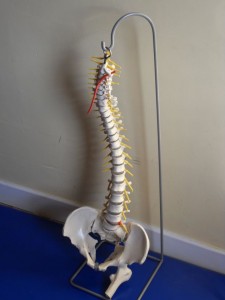USING YOUR LAPTOP
By it’s very name, the ‘lap top’ gives off the wrong message. A lap top should NOT be used on your lap.
Children need to be aware of what they are doing to their body while using a Lap Top.
As a child’s spine is growing and developing it is extremely important that any sustained postures should be those which promote good spinal development and not those which may lead to deformities of the spine.
POINTS TO CONSIDER
The Spinal Curve
This is a slightly S shaped curve which curves in at the back of the neck and low back, but curves slightly convexly at the thoracic spine
The left and right sides of the spine should be symmetrical.
The spine is made up of small bones (vertebrae) stacked on top of each other and separated by discs. The bones are held together by ligaments at the front, back and sides, and they are moved by muscles.
Bad posture, constant twisting or leaning to one side, constant hunching forwards or constant slouching may result in an imbalance in these structures as a child grows, and so it is imperative that each child is aware of how they should sit, and they should be encouraged to sit well.
As adults you may already have developed some mechanical deviations secondary to poor posture when younger, so these should not be encouraged by adopting prolonged stooped or asymmetrical positions while using the lap top.


The Weight of the Head
The head can be about 1/8 of the body weight.
If the spine is not in the correct alignment this weight falls in front of the spine, and so the neck muscles must over work to support the weight of the head. This in turn may result in trigger points developing in the neck muscles which may refer pain to the head.
This is frequently a cause of neckache in children and adolescents, and can be relieved or prevented with good posture.
It is a huge cause of headaches, and is often exaccebated by stress especially at exam time
GUIDELINES
The following are a list of guidelines for children’s posture while sitting doing studying, using console games, using computers and especially using lap tops.
The aim is to maintain the spine in as neutral a position as possible and in so doing help a child to develop good control of postural muscles to help the spine develop correctly, and help adults to reduce stress on their body.
Chair
Ideally a chair should be at hip height so that the hips, knees and ankles can be at 90° when feet are placed flat on the floor.
The depth of the seat of the chair should be such that the back can rest against the back of the chair while hips, knees and ankles remain at 90°
If the chair you have is unsuitable
- Steps can be used to bring feet up
- Cushions can be used to support spine
Desk
The study desk should be large enough to accommodate all the child’s open books, and lap top, so that they do not have to twist around to look at open books on other surfaces.
The height of the desk should be such that the child’s elbows rest on it when they are seated correctly
The area under the deck should be clear and the legs of the desk should be such that the chair can be pulled well under the desk so that the child can maintain their correct spinal posture.
Adjustable office chairs and kneeling chairs are useful if they have been properly adjusted to suit the child.
NB: The kneeling chair is excellent when used correctly, but very harmful when used incorrectly.
Lap Top / Computer
The screen should be at a level which encourages the child to hold their neck in the neutral position.
This position with a lap top is usually quite good with children, but can be a little low with older children and adults, therefore tilt the screen slightly back to encourage neck alignment
If the screen is too high the neck will tilt back
The screen should be directly in front of the child, and a lap top should only be used directly in front.
If the screen is off to one side the neck will rotate
On Your Knees / On the floor / In bed
It is virtually impossible to maintain the spine in a good neutral posture while using a lap top in any of the above positions.
If someone is ill and needs to use a lap top in bed they should use a laptop support which will angle the lap top up in front of them while they remain fully supported by pillows.
NB: It is recommended that YOU DO NOT use your lap top in bed.


